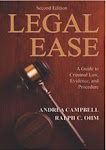The criminal justice system is a huge machine and there are always many things that serve to stop up the cogs. History has never been kind and criminal law is based on history and is a vainglorious attempt at achieving justice.
Some of the things currently plaguing the criminal justice industry are: juror’s prejudices, (the question as to whether there is a “CSI Effect?), the glorification of forensic science in crime scene dramas, the real backlog of the system, fraud by forensic experts, and incompetence with individuals who jeopardize the process among other things.
Where to begin? Whether one wants to believe there is a “CSI Effect” or not—and there are folks who have expressed their doubts—jurors need to realize that achieving justice requires a unique balance of elements, and that nothing is foolproof; and that technology is not the be all and end all for guilt.
Prosecutors are held to a standard when they bring a charging document and defendant to court. And that standard is to find: guilt beyond a reasonable doubt. That doesn’t mean that the jury must all be 100% convinced to a certainty. It means that there is sufficient evidence presented by the state that this person has committed this crime.
Now the evidence can come in a variety of forms from eyewitness identification to hard evidence or artifacts and even circumstantial evidence—such as: this person stalked the victim and had a restraining order issued against them in the past. Circumstantial evidence is a fact that can be used to infer another fact. It is built upon reasoning and expecting reasonable people to figure it out. And cases in the past, Dear Reader, have been won on circumstantial evidence. Because, if there are enough things that point to guilt: bad character evidence, no alibi, previous behavior, mental illness, stressors, whatever—sometimes a pile of things put all in one place is a mountain that cannot be ignored.
Thursday, March 15, 2007
Monday, March 5, 2007
A Few Pet Peeves
There are more than a few things that drive me crazy about how forensic science and the CSI groups are depicted on TV crime dramas. But I also have some pet peeves that don’t necessarily warrant writing a column about such as: when Delko got shot in the head just recently, died and came back, was his recovery a miracle or what? Out for so long, no brain damage and he was back at work very soon, just a little slower on the uptake. Puleese, this makes victims of TV viewers to allow people to think that this is even possible. I was kind of hoping that he was dead after I saw how they treated his “coming back.”
Okay, one time on an episode quite a long time ago (and since I don’t have the DVD set from years past,) I’ll just say that the CSI—Las Vegas team was out in the dessert and Gil Grissom was talking about “tasting a bone.” Listen, if you find remains, no way are you going to go putting it up to your lips. Can we say dangerous practice? I mean, why doesn’t that man have hepatitis C by now?
And, too, in the same vein, you will never see law enforcement stick their finger into a bag of powder, taste it and say, “that’s cocaine all right.” Wow, how irresponsible it that! It could be PCP, a dangerous hallucinogenic, or any number of harmful substances (in fact some drugs are cut with harmful chemicals themselves, like arsenic). Cops often use crip kits. These are testing kits that will determine the characteristics of a drug or chemical substance using reagents and small squirt bottles and testing vials. For more information on what a kit looks like, what you can test for, and other specifics, check out this link: http://www.cripkit.com/products/carkit.html
Okay, this is short tonight, but I feel better already for saying it.
Okay, one time on an episode quite a long time ago (and since I don’t have the DVD set from years past,) I’ll just say that the CSI—Las Vegas team was out in the dessert and Gil Grissom was talking about “tasting a bone.” Listen, if you find remains, no way are you going to go putting it up to your lips. Can we say dangerous practice? I mean, why doesn’t that man have hepatitis C by now?
And, too, in the same vein, you will never see law enforcement stick their finger into a bag of powder, taste it and say, “that’s cocaine all right.” Wow, how irresponsible it that! It could be PCP, a dangerous hallucinogenic, or any number of harmful substances (in fact some drugs are cut with harmful chemicals themselves, like arsenic). Cops often use crip kits. These are testing kits that will determine the characteristics of a drug or chemical substance using reagents and small squirt bottles and testing vials. For more information on what a kit looks like, what you can test for, and other specifics, check out this link: http://www.cripkit.com/products/carkit.html
Okay, this is short tonight, but I feel better already for saying it.
Subscribe to:
Posts (Atom)




